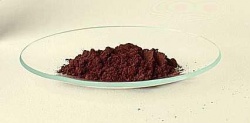Red phosphorus
From PyroGuide
Symbol: P
Synonyms: Red amorphous phosphorus, Violet phosphorus, Hittorf's phosphorus
Description: Red phosphorus is a more stable and less reactive version of phosphorus. White phosphorus would ignite at about 40o C while the red version only catches fire in the air at temperatures above 240o C. In pyrotechnics, phosphorus is used in compositions that ignite through friction and in mixtures that burn very brightly, such as Armstrong's mixture.
Hazards: Although it does not ignite spontaneously like white phosphorus, red phosphorus is a flammable solid and is readily combustible. It may be ignited by an ignition source, heat, friction, static electrical spark, oxidizing agents (such as Potassium nitrate, Potassium chlorate, Potassium perchlorate, etc.), or physical impact. If it comes into contact with oxidants (e.g., chlorine, fluorine, or bromine), red phosphorus may burn spontaneously or explode. At normal temperature and humidity, red phosphorus reacts slowly with water vapour and Oxygen in the air to form phosphine gas, which is extremely toxic!
Test: Red phosphorous has no smell, but strongly smells like ozone when contaminated with yellow P. If this is the case, place the compound in a filter-paper, wash it with hot water (60+ degrees C)and dry it well. The yellow P will melt and dissolves in the water.
Sources: Red phosphorus may be formed by heating white phosphorus to 250°C (482°F) or by exposing white phosphorus to sunlight. There is also a method to obtain it by dissolving the strike plates taken off matchbook covers in acetone. It may also be sanded off the matchbook strike plates, but may result in paper contamination.
Hazard Symbols: N, F

